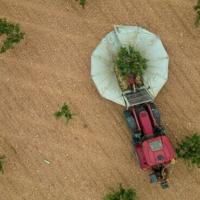Twenty years ago, Miguel Angel Garcia worked on his family farm in central Spain, harvesting grapes and grains passed down through generations. Today, he has transitioned to growing pistachios, a more profitable crop that can better withstand the increasing frequency and intensity of droughts in Spain.
At his 26-hectare (64-acre) farm in Manzanares, part of the Castilla-La Mancha region, Garcia now harvests 10 to 20 tonnes of pistachios each year, joining the pistachio production boom in Spain.
“Growing wine and cereals was no longer sustainable,” said the 58-year-old, who planted his first pistachio trees in 2007. “If I hadn’t made the change, I wouldn’t have been able to support myself with my farm.”
In the rocky terrain behind him, an electric harvester shakes small pistachio trees, causing the nuts to fall onto a large canvas below.
Pistachio trees, native to the Middle East, are well-suited to Spain’s climate with its hot, dry summers and cold winters, Garcia explained.
The area of land dedicated to pistachio trees in Spain has increased almost five times since 2017, reaching 79,000 hectares (195,000 acres) by 2024, according to agriculture ministry data.
– ‘Strong demand’ –
Spain is now the largest pistachio producer in Europe by area, ranking fourth in the world after the United States, Iran, and Turkey.
Most pistachios are grown in Castilla-La Mancha, Extremadura, and Andalusia, regions facing water scarcity due to climate change.
Pistachios, originating from arid regions, are well-adapted to Spain’s changing climate conditions, said Mario Gonzalez-Mohino, an agricultural engineer and director of Pistacho Pro.
Spain had its hottest August on record this year, with temperatures averaging 25 degrees Celsius (77 degrees Fahrenheit), and 2024 is forecasted to be one of the warmest years ever recorded.
While Spain’s annual pistachio production of nearly 9,000 tonnes is considered limited, it is expected to grow rapidly as more trees come into production, typically taking at least seven years to yield the first harvest.
Joaquin Cayuela Verges, secretary general of the Pistamancha agricultural cooperative, which includes 51 pistachio farms, believes the boom is just beginning.
“There is high demand, and it’s a dynamic sector,” he said.
The cooperative sells 90% of its pistachio production in Europe, primarily to France and Germany, at 10-11 euros per kilo (around $5 per pound).
– ‘A matter of patience’ –
To keep up with the rapid growth, Pistamancha is investing five million euros in a new processing plant for sorting, peeling, and drying pistachios. When completed, the plant will be able to process one million kilos of pistachios per year.
Could this growth lead to an oversupply that drives down prices? Industry experts see little risk as Spanish pistachio production still falls short of domestic demand.
Most pistachios consumed in Spain are imported, primarily from the United States, according to Gonzalez-Mohino, who foresees a promising future for Spanish pistachio producers.
Pistachios are popular as snacks and are widely used in Middle Eastern cuisine, as well as in baking, confectionery, ice cream, and cosmetics production.
“Many people think they will get rich quickly by planting pistachio trees, but it requires several years before seeing any returns,” Garcia noted. “After 15 years of investment, I am now starting to see profits. Patience is key when it comes to pistachios.”
vab/mdm/ds/js/lth





